Papers by Dimitrios Galaris

Free Radical Research, 2005
In search for compounds, able to protect nuclear DNA in cells exposed to oxidative stress, extrac... more In search for compounds, able to protect nuclear DNA in cells exposed to oxidative stress, extracts from olive leaves, olive fruits, olive oil and olive mill waste water were tested by using the "single cell gel electrophoresis" methodology (comet assay). Jurkat cells in culture were exposed to continuously generated hydrogen peroxide (11.8+/-1.5 microM per min) by direct addition into the growth medium of the appropriate amount of the enzyme "glucose oxidase" in the presence or absence of the tested total extracts. The protective effects of the tested extracts or isolated compounds were evaluated from their ability to decrease hydrogen peroxide-induced formation of single strand breaks in the nuclear DNA, while the toxic effects were estimated from the increase of DNA damage when the extracts or isolated compounds were incubated directly with the cells. Significant protection was observed in extracts from olive oil and olive mill waste water. However, above a concentration of 100 microg/ml olive oil extracts exerted DNA damaging effects by themselves in the absence of any H2O2. Extracts from olive leaves and olive fruits although protective, were also able to induce DNA damage by themselves. Main compounds isolated from the above described total extracts, like oleuropein glucoside, tyrosol, hydroxytyrosol and caffeic acid, were tested in the same experimental system and found to exert cytotoxic (oleuropein glucoside), no effect (tyrosol) or protective effects (hydroxytyrosol and caffeic acid). In conclusion, cytoprotective as well as cytotoxic compounds with potential pharmaceutical properties were detected in extracts from olive oil related sources by using the comet assay methodology.
Critical Reviews in Oncology/Hematology, 2002
Metals are necessary for the normal functioning of cells and the survival of organisms. However, ... more Metals are necessary for the normal functioning of cells and the survival of organisms. However, exposure to higher than the physiological levels of several metals may lead to tumor development. Although the exact molecular mechanism(s) of metal-induced carcinogenesis is not clear, a vast body of evidence indicates that metal-induced generation of reactive oxygen species (ROS) may play a central role in this process. Two main pathways of ROS-induced effects are discussed in this chapter: (i) increased DNA damage induced either directly or indirectly by impeding DNA repair, and (ii) modulation of nuclear transcriptional factor activities, such as NF-kB and AP-1, through mitogen-activated protein kinases signal transduction mechanisms.
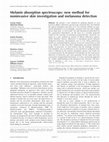
Journal of Biomedical Optics, 2008
We present a new method for studying melanin in vivo based on diffuse reflectance spectroscopy of... more We present a new method for studying melanin in vivo based on diffuse reflectance spectroscopy of human skin. We find that the optical absorption spectrum of in vivo melanin exhibits an exponential dependence on wavelength, consistent with, but with a higher decay slope than, in vitro results. We offer theoretical justification for this exponential dependence on the basis of a recently proposed model for the structure of eumelanin protomolecules. Moreover, we report on a new method for analysis of diffuse reflectance spectra, which identifies intrinsic differences in absorption spectra between malignant melanoma and dysplastic nevi in vivo. These preliminary results are confirmed both by analysis of our own clinical data as well as by analysis of data from three independent, previously published studies. In particular, we find evidence that the histologic transition from dysplastic nevi to melanoma in situ and then to malignant melanoma is reflected in the melanin absorption spectra. Our results are very promising for the development of techniques for the noninvasive detection of melanoma and, more generally, for the study and characterization of pigmented skin lesions. It is also a promising approach for a better understanding of the biological role, structure, and function of melanin.
Biochemical and Biophysical Research Communications, 1989
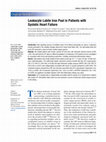
Hellenic journal of cardiology : HJC = Hellēnikē kardiologikē epitheōrēsē, 2012
Data regarding sources of oxidative stress in the failing myocardium are sparse. Leukocytes activ... more Data regarding sources of oxidative stress in the failing myocardium are sparse. Leukocytes actively participate in the oxidative damage observed in human heart failure (HF). The intracellular labile iron pool (LIP) represents a source of toxic reactive oxygen species. We studied patients with chronic systolic HF who had a left ventricular ejection fraction (LVEF) 45%. We examined the LIP status in different populations of leukocytes in HF patients and we investigated its association with clinical and laboratory parameters, including conventional inflammatory markers. Sixty patients were finally included in the analysis (mean age: 67 ± 11 years, 54 men, 42 with ischemic cardiomyopathy). The multivariate logistic regression analysis showed that only LIP in granulocytes (OR: 0.73; 95% CI: 0.55-0.98; p=0.039) and right ventricular systolic pressure (RVSP) (OR: 0.95; 95% CI: 0.92-0.99; p=0.027) were independently associated with severe LV systolic dysfunction (LVEF30%). The correlation ...

International Journal of Cardiology, 2007
Atrial fibrillation (AF) is the most common arrhythmia encountered in clinical practice represent... more Atrial fibrillation (AF) is the most common arrhythmia encountered in clinical practice representing a major health hazard. Owing to relative inefficacy and side effects of classic antiarrhythmic drugs, current interest has shifted to treatments that target AF substrate. Accumulating evidence suggests that there is a link between oxidative processes and AF. In atrial myocardium during AF, there is substantial oxidative damage that may contribute to atrial remodeling. Several pathophysiological changes that possibly associated with increased oxidative stress in AF have been proposed. These include changes in gene transcriptional profiles and mitochondrial DNA, increased activity of enzymes such as NAD(P)H oxidase and xanthine oxidase, inflammatory processes, activation of the renin-angiotensin system and others. Moreover, oxidative stress is involved in the pathophysiology of several predisposing factors and cardiovascular disorders that correspondingly associated with AF. Preliminary studies using dietary antioxidants such as vitamin C have shown promising results. More evidence has been obtained from studies examining agents with pleiotropic effects, including antioxidant, such as inhibitors of the renin-angiotensin system, statins, corticosteroids and carvedilol. Further investigations are needed in order to elucidate the impact of oxidative stress on atrial remodeling. The clarification of these processes in the setting of AF may lead to the development of novel therapeutic strategies.
International Journal of Cardiology, 2003
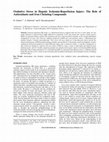
Current Pharmaceutical Design, 2006
Ischemia-reperfusion (IR) injury is a multifactorial process triggered when the liver or other or... more Ischemia-reperfusion (IR) injury is a multifactorial process triggered when the liver or other organs are transiently subjected to reduced blood supply followed by reperfusion. It has been shown that "reactive oxygen species" (ROS) are generated during ischemia and reperfusion and may represent pivotal mediators of the ensuing pathological complications. In some cases, however, moderate production of ROS may exert protective effects, a phenomenon presumably related to "ischemic preconditioning". This review will focus mainly on: a) describing the sources and the biochemical mechanisms of ROS generation during ischemia and reperfusion, b) discussing current developments in understanding the biochemical pathways by which ROS may induce toxic or protective effects, c) critically evaluating the results of previous attempts to counteract the toxic effects of ROS by using a variety of antioxidant and transition metalchelating agents, and d) if feasible, proposing potential new pharmaceutical agents aimed at ameliorating ROS-inducing deleterious effects during reperfusion. It is concluded that ROS are generated from different sources, at different periods during IR, and may act by a variety of not well understood biochemical mechanisms which ultimately lead to cell damage and tissue failure.
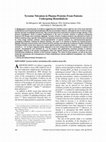
American Journal of Kidney Diseases, 2004
Background: A growing body of evidence suggesting that oxidative stress might be one of the most ... more Background: A growing body of evidence suggesting that oxidative stress might be one of the most important complications occurring during hemodialysis (HD) has accumulated. However, although the role of reactive oxygen species has been investigated extensively, little is known about the involvement of reactive nitrogen species. In the present investigation, levels of protein modifications in the form of tyrosine nitration in patients undergoing long-term HD therapy were evaluated. Methods: Tyrosine nitration of plasma proteins was detected by means of Western blotting using a specific nitrotyrosine-recognizing monoclonal antibody, and band intensity was evaluated by using image analysis software. Immunoprecipitation of plasma proteins by antinitrotyrosine-agaroseconjugated antibodies, followed by Western blotting, was used in an attempt to identify the nitrated proteins. Results: Although several proteins with nitrated tyrosine residues were observed in plasma of healthy individuals, increased nitration levels were observed in some specific proteins in all patients tested (n ؍ 25) compared with controls (n ؍ 6). At least 6 apparent bands appeared to be more nitrated than their counterparts in plasma from controls. Ceruloplasmin was identified as 1 of the proteins with significantly increased nitration in patients. Conclusion: Results of the present investigation show that specific plasma proteins of HD patients are posttranslationally modified by nitration of their tyrosine residues. The nature of these proteins, as well as the exact molecular mechanisms and consequences of these modifications, warrant additional investigation.
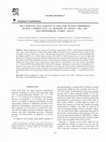
Free Radical Biology and Medicine, 2001
Human lymphocytes were exposed to increasing concentrations of SIN-1, which generates superoxide ... more Human lymphocytes were exposed to increasing concentrations of SIN-1, which generates superoxide and nitric oxide, and the formation of single-strand breaks (SSB) in individual cells was determined by the single-cell gel electrophoresis assay (comet assay). A dose-and time-dependent increase in SSB formation was observed rapidly after the addition of SIN-1 (0.1-15 mM). Exposure of the cells to SIN-1 (5 mM) in the presence of excess of superoxide dismutase (0.375 mM) increased the formation of SSB significantly, whereas 1000 U/ml catalase significantly decreased the quantity of SSB. The simultaneous presence of both superoxide dismutase and catalase before the addition of SIN-1 brought the level of SSB to that of the untreated cells. Moreover, pretreatment of the cells with the intracellular Ca 2ϩ-chelator BAPTA/AM inhibited SIN-1-induced DNA damage, indicating the involvement of intracellular Ca 2ϩ changes in this process. On the other hand, pretreatment of the same cells with ascorbate or dehydroascorbate did not offer any significant protection in this system. The data suggest that H 2 O 2-induced changes in Ca 2ϩ homeostasis are the predominant pathway for the induction of SSB in human lymphocytes exposed to oxidants.
Critical Reviews in Clinical Laboratory Sciences, 2008
Iron is an essential cofactor for important biological activities and biochemical reactions, incl... more Iron is an essential cofactor for important biological activities and biochemical reactions, including the transport of oxygen via red blood cells and its reduction to water during respiration. While iron's bioavailability is generally limited, pathological accumulation of the metal within tissues aggravates the generation of reactive oxygen species (ROS) and elicits toxic effects, which are mainly related to oxidative stress. Here, we describe the role of iron in ROS-induced toxicity and discuss molecular mechanisms and physiological aspects of ROS-and iron-mediated signaling. In addition, we review our current understanding of the regulation of iron homeostasis at the cellular and systemic levels, and focus on the pathogenesis and management of iron overload disorders.
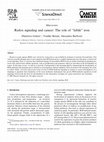
Cancer Letters, 2008
Reactive oxygen species (ROS) were viewed for a long time as unavoidable by-products of normal ce... more Reactive oxygen species (ROS) were viewed for a long time as unavoidable by-products of normal cell catabolism. This view has recently changed and it is now apparent that ROS generation is a tightly regulated process that plays a central role in cell signaling. Thus, it is known that regulated changes in intracellular ROS levels can induce biochemical signaling processes that control basic cellular functions, such as proliferation and apoptosis which are prevalent in the development of cancer. In this short review, we will try to provide a background to this emerging field by summarizing the biochemistry of ROS-mediated cell signaling and its relation to carcinogenesis. Special emphasis will be focused on the emerging role of the so called ''labile" iron (the redox-active form of iron) in ROS-mediated signaling in relation to cancer development. It is tempting to speculate that elucidation of the exact molecular mechanisms that govern ROS-mediated regulation of cell signaling will provide the basis for development of new therapeutic strategies for cancer prevention and treatment.

Biochimica et biophysica acta. General subjects, Sep 1, 2018
Flavonoids possess a rich polypharmacological profile and their biological role is linked to thei... more Flavonoids possess a rich polypharmacological profile and their biological role is linked to their oxidation state protecting DNA from oxidative stress damage. However, their bioavailability is hampered due to their poor aqueous solubility. This can be surpassed through encapsulation to supramolecular carriers as cyclodextrin (CD). A quercetin- 2HP-β-CD complex has been formerly reported by us. However, once the flavonoid is in its 2HP-β-CD encapsulated state its oxidation potential, its decomplexation mechanism, its potential to protect DNA damage from oxidative stress remained elusive. To unveil this, an array of biophysical techniques was used. The quercetin-2HP-β-CD complex was evaluated through solubility and dissolution experiments, electrochemical and spectroelectrochemical studies (Cyclic Voltammetry), UV-Vis spectroscopy, HPLC-ESI-MS/MS and HPLC-DAD, fluorescence spectroscopy, NMR Spectroscopy, theoretical calculations (density functional theory (DFT)) and biological evalua...
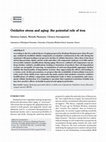
HORMONES
According to the free radical theory of aging proposed by Denham Harman more than 50 years ago, o... more According to the free radical theory of aging proposed by Denham Harman more than 50 years ago, oxidatively modified cellular components accumulate continuously in the cells during the organism's lifespan leading to progressive decline of cellular functions. Since then, it has been shown that proteins, lipids, nucleic acids and other cell components undergo reversible and/or irreversible oxidative modifications during aging. Moreover, oxidized cell components can undergo further oxidative modifications leading to formation of products that cell degradation systems are incapable of removing. Accumulation of such non-degradable aggregates further inhibits the functionality of degradation systems, thus aggravating the effects and leading to a vicious cycle. In this presentation, we propose that the availability of intracellular iron in its redox active form (labile iron) represents the main catalyst that mediates extensive oxidative modifications of cellular components and ultimate...
European Journal of Heart Failure, 2000
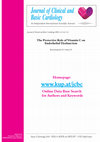
Journal of clinical and basic cardiology, 2003
A major function of endothelium is the secretory control of smooth muscle vascular tone. The prin... more A major function of endothelium is the secretory control of smooth muscle vascular tone. The principal vasodilator substance excreted is nitric oxide (NO), a molecule that is under thorough investigation. There is sufficient evidence that its bioavailability is reduced in many diseases such as coronary artery disease, heart failure, dyslipidaemias, obesity, diabetes, renal failure, and others. The interactions of this molecule with reactive oxygen species are believed to constitute an important pathophysiological pathway. Consequently, intensive research is under way to evaluate the efficacy of various antioxidant interventions against endothelial dysfunction. Vitamin C is an outstanding hydrophilic antioxidant, which is able to scavenge many reactive oxygen species. When infused or chronically ingested in pharmacological doses it substantially improves the defective endothelium-dependent vasodilation involved in the above-mentioned clinical conditions. Several molecular mechanisms ...
Eλeύθeρeς ρίζeς:Βιοχημeία και Παθολογική Βιοχημeία [ΠΑΝEΠΙΣΤΗΜΙΟ ΙΩΑΝΝΙΝΩΝ, ΣΧΟΛΗ EΠΙΣΤΗΜΩΝ ΥΓEΙΑ... more Eλeύθeρeς ρίζeς:Βιοχημeία και Παθολογική Βιοχημeία [ΠΑΝEΠΙΣΤΗΜΙΟ ΙΩΑΝΝΙΝΩΝ, ΣΧΟΛΗ EΠΙΣΤΗΜΩΝ ΥΓEΙΑΣ, ΤΜΗΜΑ ΙΑΤΡΙΚΗΣ]
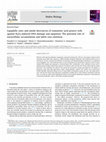
Redox Biology
Phenolic acids represent abundant components contained in human diet. However, the negative charg... more Phenolic acids represent abundant components contained in human diet. However, the negative charge in their carboxylic group limits their capacity to diffuse through biological membranes, thus hindering their access to cell interior. In order to promote the diffusion of rosmarinic acid through biological membranes, we synthesized several lipophilic ester-and amide-derivatives of this compound and evaluated their capacity to prevent H 2 O 2induced DNA damage and apoptosis in cultured human cells. Esterification of the carboxylic moiety with lipophilic groups strongly enhanced the capacity of rosmarinic acid to protect cells. On the other hand, the amidederivatives were somewhat less effective but exerted less cytotoxicity at high concentrations. Cell uptake experiments, using ultra-high performance liquid chromatography coupled with tandem mass spectrometry (UHPLC-MS/MS), illustrated different levels of intracellular accumulation among the ester-and amide-derivatives, with the first being more effectively accumulated, probably due to their extensive hydrolysis inside the cells. In conclusion, these results highlight the hitherto unrecognized fundamental importance of derivatization of diet-derived phenolic acids to unveil their biological potential.
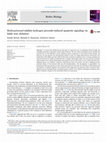
Redox Biology, 2016
Although it is known that Mediterranean diet plays an important role in maintaining human health,... more Although it is known that Mediterranean diet plays an important role in maintaining human health, the underlying molecular mechanisms remain largely unknown. The aim of this investigation was to elucidate the potential role of ortho-dihydroxy group containing natural compounds in H 2 O 2-induced DNA damage and apoptosis. For this purpose, the main phenolic alcohols of olive oil, namely hydroxytyrosol and tyrosol, were examined for their ability to protect cultured cells under conditions of oxidative stress. A strong correlation was observed between the ability of hydroxytyrosol to mitigate intracellular labile iron level and the protection offered against H 2 O 2-induced DNA damage and apoptosis. On the other hand, tyrosol, which lacks the orthodihydroxy group, was ineffective. Moreover, hydroxytyrosol (but not tyrosol), was able to diminish the late sustained phase of H 2 O 2-induced JNK and p38 phosphorylation. The derangement of intracellular iron homeostasis, following exposure of cells to H 2 O 2 , played pivotal role both in the induction of DNA damage and the initiation of apoptotic signaling. The presented results suggest that the protective effects exerted by orthodihydroxy group containing dietary compounds against oxidative stress-induced cell damage are linked to their ability to influence changes in the intracellular labile iron homeostasis.










Uploads
Papers by Dimitrios Galaris